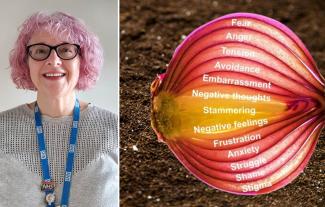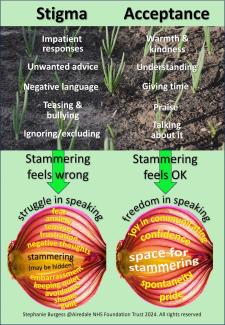Therapy explained through the stammering onion

Steph Burgess tells us how she uses the metaphor of the stammering onion to help parents take a more accepting approach to their child's stammer.
How do we explain that it's OK to stammer, while at the same time offering therapy to people who stammer? One thing that can help with this is the metaphor of 'the stammering onion'.
The stammering onion shows how layers of physical and emotional struggle can gradually build up around the stammer, potentially causing concealment and avoidance. While the metaphor has been around for a while, I devised the infographic above to demonstrate these layers.
The aim of therapy is to reduce the struggle, allowing space for stammering and more comfortable talking.
Preventing the build up of layers
More recently, I felt it would be helpful to show WHY the layers build up. I created a new infographic to show that how the onion seedlings develop is influenced by whether they grow in shade and poor soil (stigma) or sunshine and good soil (acceptance). It illustrates that much of the struggle comes from an instinctive coping response to other peoples' often negative or unhelpful reactions to stammering.

The infographic helps parents to understand that an accepting approach towards their child's stammer can prevent those layers of struggle, enabling freedom in speaking. It also changes the way they offer praise. Rather than praising fluent speech, I encourage parents to praise their child's general communication skills, particularly when they are stammering, in order to boost the child's confidence in their own natural way of talking.
If parents are struggling to know how to do this, I might give them ideas of things they could say to their child, eg, "That's a great word you used. I loved the way you explained that. You're such a great talker! This is so interesting — tell me more!"
Reducing the struggle
Many parents find it hugely reassuring to hear that it's OK to stammer and there's nothing wrong with how their child speaks. However, others might find that idea more difficult to accept and be hoping for some kind of fix. As speech & language therapists, we must resist colluding in this. That requires sensitivity and empathy in our conversation with parents as they navigate their own journey with stammering.
I am always honest about the fact that stammering can't be fixed. That doesn't mean that I don't ever help people to modify their speech. If a person believes there are things they simply can't say, then I might teach strategies which both reduce the struggle and reinforce the belief that they CAN say it. This is not the same as fluency shaping where the goal is to reduce stammering, since this can lead to masking and concealment.
Using visual resources like the stammering onion can really help in explaining these difficult concepts. It also helps parents to understand why it's not necessary and indeed potentially harmful to 'treat' children in cases where there's no struggle and they're communicating confidently. I welcome the fact that in the UK the profession has largely shifted to a stammering-affirming approach. Therapy programmes which claim to reduce or eliminate stammering only reinforce the stigmatising message that stammering is undesirable and thus add to the negative layers of the onion — this is borne out in my discussions with adults who stammer, some of whom relate traumatising experiences of speech therapy as a child. It is to be hoped that these harmful approaches will soon be entirely consigned to the dustbin of history.
The onion can also help to guide the direction of therapy, since the layers don't always remain static. They may grow or shrink depending on how the person is feeling, what situation they're in or who they're talking to. As we adapt our therapy to each individual's changing needs and goals, we must remain focused on freedom in speaking, regardless of whether stammering is happening or not.
With grateful thanks to Nic Maddy, Alex Harrison and Cameron Raynes for proof-reading and suggesting amendments.
Steph Burgess is the Stammering Service Lead at Airedale NHS Foundation Trust.
Would you like to contribute an article for Your Voice? Share your opinions or tell the community about your experiences of stammering. See Submit Something For The Site or email editor@stamma.org for details.

































